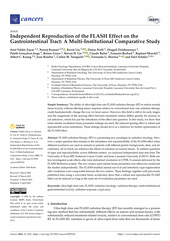Abstract
FLASH radiation therapy (RT) is a promising new paradigm in radiation oncology. However, a major question that remains is the robustness and reproducibility of the FLASH effect when different irradiators are used on animals or patients with different genetic backgrounds, diets, and microbiomes, all of which can influence the effects of radiation on normal tissues. To address questions of rigor and reproducibility across different centers, we analyzed independent data sets from The University of Texas MD Anderson Cancer Center and from Lausanne University (CHUV). Both centers investigated acute effects after total abdominal irradiation to C57BL/6 animals delivered by the FLASH Mobetron system. The two centers used similar beam parameters but otherwise conducted the studies independently. The FLASH-enabled animal survival and intestinal crypt regeneration after irradiation were comparable between the two centers. These findings, together with previously published data using a converted linear accelerator, show that a robust and reproducible FLASH effect can be induced as long as the same set of irradiation parameters are used.
*Ultra-High Dose Rate (UHDR) functionality for FLASH Radiotherapy is for investigational use only and is not cleared for sale by the US FDA.
